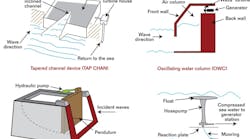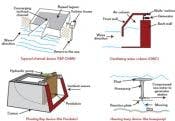By Béla Lipták
A hundred years ago, only 3% of homes had electricity. It is probable that 100 years from now, 97% of us will live in “zero energy” homes, and only 3% will depend on receiving fuel and energy from the outside.
In the previous parts of this series, I discussed the abundant availability of clean and inexhaustible solar energy. I also noted that process control can double the efficiency of solar collection (from 14% to over 30%) by following the sun and focusing the collected energy onto a stationary solar converter. Before proceeding to the discussion of the “zero energy home of the future” and the hydrogen economy, one should also mention the potentials of process control in wind, ocean wave, and geothermal energy systems.
Wind Turbines
Down on the wind farm
In many locations, the electricity generated by wind farms, is already cost competitive
In May 2007, the National Academy of Sciences released a study indicating that wind turbines could reduce the nation’s carbon dioxide generation by 4.5% by 2025. Between 2000 and 2006, the electricity generated by wind farms quadrupled, but the energy generated by them still corresponds to less than 1% of the total national consumption. The U.S. Department of Energy estimates that, in the next 15 years, the combined capacity of wind generators will reach from 19 gW to 72 gW, which corresponds to 2% to 7% of the national electricity generating capacity. According to a European estimate, if fully exploited, Europe could meet 30% of its electricity needs by wind power.
In fact, wind turbine-generated electricity already is cost competitive. It’s in the range of 4-6 cents/kWh and dropping, while the average electricity cost from the power companies is about 12 cents/kWh. In many parts of the world, government support is available to finance wind turbine installations. In California, for example, a $32,000 wind turbine (about 12 ft. in diameter and 30-100 ft. tall) is supported by a $16,000 state rebate. The generating capacity of the average wind turbine in the U.S. is 2 kW to 10 kW, and the federal government is considering supporting their use with a one-time credit of $3,000/kW.
In addition, in many locations, the excess electricity that wind turbines generate is accepted by power companies on a “net metering” basis, in which meters “run backwards” when the excess electricity is sent into the grid. The turbines are sized so the accumulation of this excess will compensate for (or exceed) the amount of electricity needed when there is no wind.
In order to meet wilderness preservation considerations, it’s suggested that birds, bats, and other animals can be protected, if larger, more slowly rotating blades are used. To meet objections to wind turbines from an aesthetic point of view, artists are coming up with a variety of visually pleasing shape and color combinations.
Ocean Wave Energy
Wave power
Ocean wave energy collection design.
Courtesy of World Energy Council - WEC
Another renewable energy source is ocean wave energy. It’s been studied for nearly four decades, but it’s exploitation is just beginning. Dr. Tom Thorpe of ETSU says the highest energy waves are concentrated off the western coasts in the 40o to 60o latitude range north and south.
The power in the wave fronts varies in these areas is between 30 kW/m and 70 kW/m, with peaks up to 100 kW/m in the Atlantic southwest of Ireland, the Southern Ocean, and off Cape Horn. If this energy resource were harnessed, it could meet 10% of the global electricity demand.
Some of the ocean wave energy collector designs are shown in Figure 2. On the top left of the figure is the “Tapered Channel” design. Here, the waves enter a raised lagoon through a converging inclined channel from which the water returns through a turbine generator back into the ocean. On the top right, the oscillating or assisted water column (OWC) is shown. In that collector design, the energy of the ocean waves is used to pump air through an air turbine generator.
On the lower left of Figure 2, the energy of the incident waves act upon a pivoted pendulum (the “pendulor”), and this energy is used to drive a hydraulic pump. On the bottom right, the collector is a heaving buoy device. Here a hose-pump is operated by the force developed between a float and a reaction plate as the energy of the pumped water is converted to electricity.
A more recent design is the Pelamis Wave Energy Converter from Ocean Power Delivery Ltd. The pelamis (named after a sea snake), which is under development in Scotland, is a series of cylindrical segments connected by hinged joints. As waves run down the length of the device, they move the joints, and the hydraulic cylinders incorporated in the joints pump oil to drive a hydraulic motor by means of an energy-smoothing system. Electricity generated in each joint is transmitted to shore by a common sub-sea cable. The planned slack-moored device will be about 130 m long and 3.5 m in diameter. The full-scale version will have a continuously rated power output of 0.75 mW.
Geothermal Energy
Geothermal energy is just as inexhaustible and renewable as solar energy, and has the added advantage of being a continuously available energy source. Its production cost is less than that of fossil energy, but its front-end expenses can be high, if the production wells are deep and the ground is rocky. The temperature in the core of the earth, thanks to the decay of radioactive isotopes, is on the order of 4,000 °C, lava from volcanoes is about 1,200 °C, and thermal spring temperatures can reach 350 °C.
Geothermal energy
Geothermal energy can be used for both heat and electricity generation.
(Source: Geothermal energy, 1998, University of Utah)
If the groundwater temperature exceeds 150 °C, “flash steam” power plants can be built. If the water temperature is between 100 °C and 150 °C, “binary cycle” power plants can be operated. At regular groundwater temperatures (as shown on the left of Figure 3), “geothermal heat pumps” (GHP) can be used to heat buildings in the winter and cool them in the summer. For example, the buildings at Bard College, Annandale-on-Hudson, N.Y., are heated by heat pumps that take heat from ground water, which is at year-around temperature of 50-60° F, and pump it into the buildings to supply hot air at around 120 °F. In all three cases, after the heat content of the geothermal water is used, the spent fluid is returned into the underground water reservoir to maintain its pressure.
In heating mode, the GHP operates the same way as a domestic refrigerator, except that instead of removing the heat from the inside and rejecting it to the outside, it takes the heat from groundwater, and moves it into the hot water or hot air that is used to heat the house.
In case of “flash steam” power plants, steam is either generated directly by the production wells, or the wells produce hot water from which steam can be separated to drive conventional steam turbine generators. The size of these plants ranges from 100 kW to 150 mW.
In “binary cycle” power plants (on the right of Figure 3), where the water in the ground is not that hot, a heat pump and a secondary working fluid are used to operate the turbine generator. In this case, the 100° C and 150° C water exchanges its heat content in a heat exchanger (evaporator) by vaporizing the working fluid. This vapor in turn drives the turbine generator, while the turbine exhaust is re-condensed by conventional cooling. These plants range in size from 100 kW to 40 mW.
In the next part of this series, I will discuss the design and control of the “zero energy home” of the future.
Béla Lipták is editor of the Instrument Engineers’ Handbook, former chief engineer of C&R (later John Brown) and former adjunct professor of Yale University. He can be reached at [email protected].
| About the Author |









